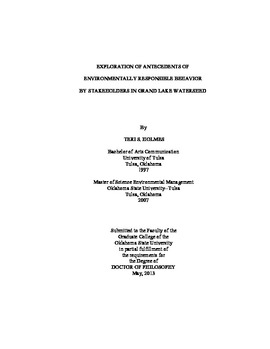| dc.contributor.advisor | Caneday, Lowell | |
| dc.contributor.author | Holmes, Teri S. | |
| dc.date.accessioned | 2014-09-24T14:16:31Z | |
| dc.date.available | 2014-09-24T14:16:31Z | |
| dc.date.issued | 2013-05 | |
| dc.identifier.uri | https://hdl.handle.net/11244/10967 | |
| dc.description.abstract | Grand Lake O' the Cherokees in Oklahoma is one of two lakes in the State of Oklahoma that allows private ownership and development of the shoreline. This has created water quality issues attributed to phosphorus levels in effluent waste water from septic systems and municipal water treatment facilities, as well as nutrient and sediment contamination from nonpoint source runoff. In the Grand Lake Watershed Basin, there are currently twenty segments listed on the Missouri 303(d) Clean Water Act (CWA) list as impaired for nutrients and eighty segments listed on the Kansas 303(d) Clean Water Act (CWA) list as impaired by organic enrichment and eutrophication The purpose of this study was to evaluate Grand Lake Watershed Basin stakeholder perceptions of the Grand Lake water quality issues to gain an understanding of the phenomenon and facilitate more effective education outreach programs and policy development. | |
| dc.description.abstract | Utilizing Q-Method, 19 participants provided ranked order sorting arrays for 36 statements encompassing six behavioral antecedents for environmentally responsible behavior. The six behavioral antecedents, based on previous research on environmentally responsible behavior, included ascription of responsibility, knowledge and awareness, locus of control, sense of place, place protection, and motivation. Four perspectives emerged from the study data demonstrating that different levels and combinations of behavioral antecedents affect how people construct their understanding of an environmental problem creating perspectives that function to define both the individual's idea of the problem and their role in the problem resolution. | |
| dc.description.abstract | Factor 1 provided insight into previous models on environmentally responsible behavior linking high levels of ascription of responsibility, locus of control and knowledge to intention to act on an environmentally responsible behavior while Factor 2 contributed to the understanding of strong sense of place and place protection elements in environmentally responsible behavior. Factor 3 and factor 4 were limited by the small sample size, but each provided enlightenment on perspectives derived from low levels of knowledge or internal locus of control for the issue, in combination with the other antecedents. These findings support the need for greater discernment of human perspectives associated with environmental issues in order to affect improvement through behavior change. | |
| dc.format | application/pdf | |
| dc.language | en_US | |
| dc.rights | Copyright is held by the author who has granted the Oklahoma State University Library the non-exclusive right to share this material in its institutional repository. Contact Digital Library Services at lib-dls@okstate.edu or 405-744-9161 for the permission policy on the use, reproduction or distribution of this material. | |
| dc.title | Exploration of antecedents of environmentally responsible behavior by stakeholders in Grand Lake watershed | |
| dc.contributor.committeeMember | Cho, Yoonjung | |
| dc.contributor.committeeMember | Gustavson, Kevin | |
| dc.contributor.committeeMember | Ede, Ken | |
| osu.filename | Holmes_okstate_0664D_12607.pdf | |
| osu.accesstype | Open Access | |
| dc.type.genre | Dissertation | |
| dc.type.material | Text | |
| dc.subject.keywords | ascription of responsibility | |
| dc.subject.keywords | environmentally responsible behavior | |
| dc.subject.keywords | knowledge | |
| dc.subject.keywords | locus of control | |
| dc.subject.keywords | motivation | |
| dc.subject.keywords | q-method | |
| thesis.degree.discipline | Environmental Science | |
| thesis.degree.grantor | Oklahoma State University | |
